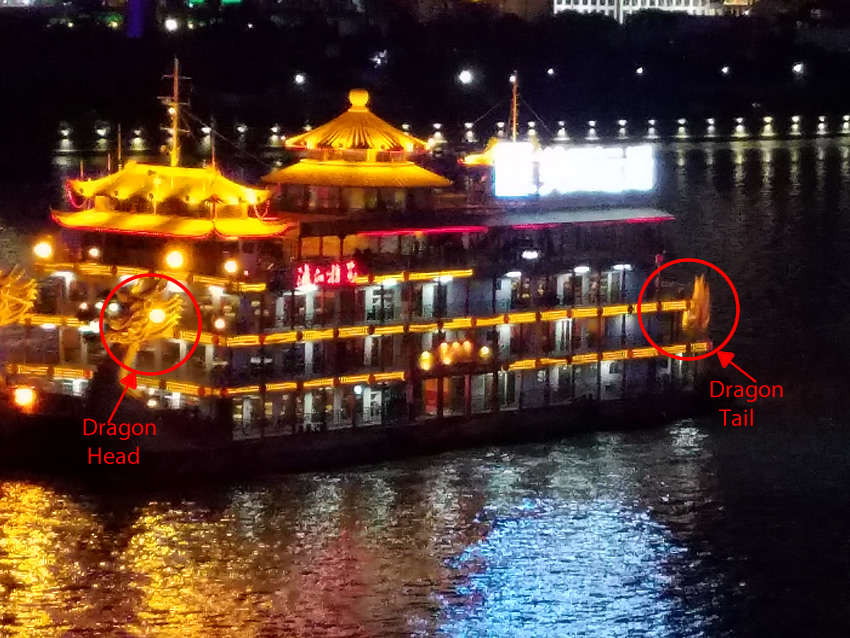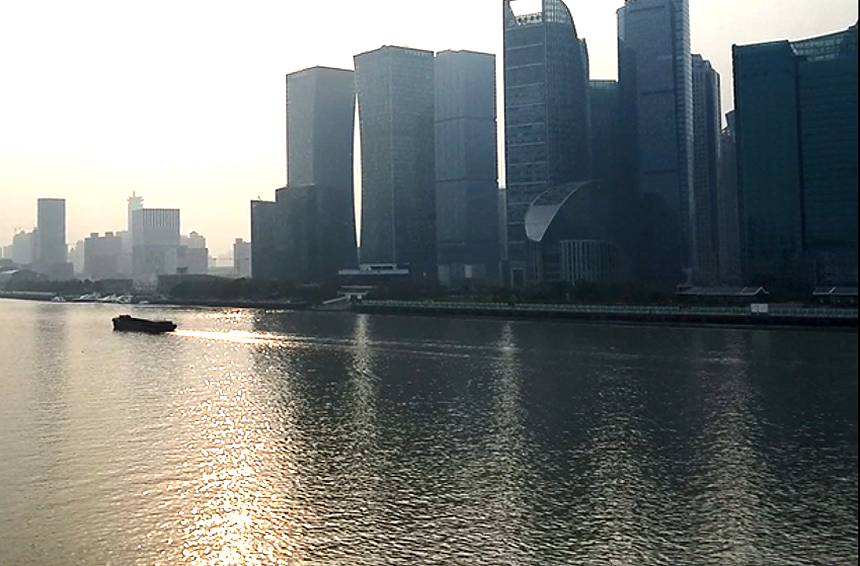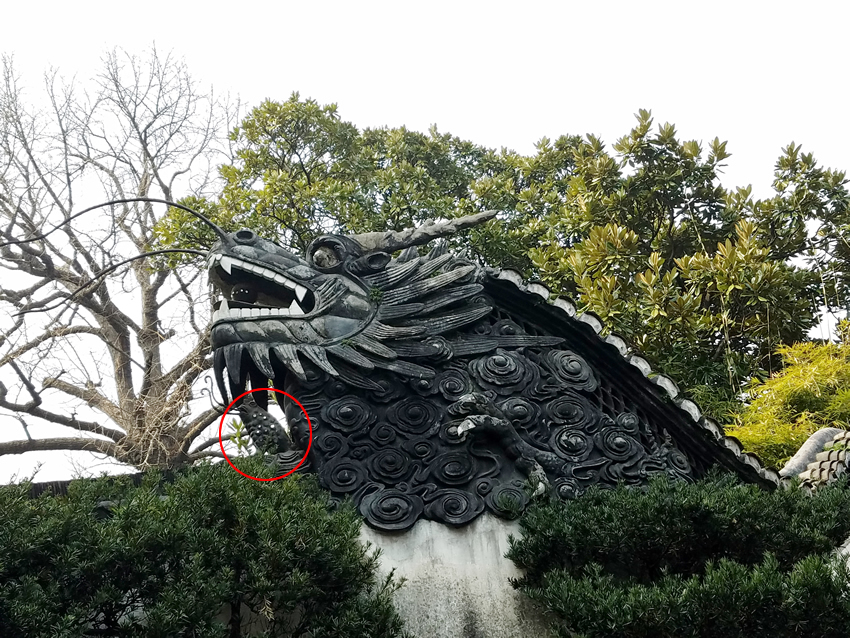Shanghai Feb 26 & 27, 2017
Shanghai is beyond words! If one could afford to stay here for six months it would be touch and go whether one could experience all it has to offer. Just a few examples, the Jewish Museum, a trip to the top of the Shanghai tower for a bird's eye view of the city, Nangking Road (a busy shopping area), and the Liu Gardens. The skyline goes on forever. And each building a different shape: one shaped like a boat, another called the bottle opener that has a parabolic opening in the top, another shaped like a rocket. Plus numerous interesting places to visit and explore.
When we were here 13 years ago, we had a “night tour” of downtown Shanghai to show us the lights, meaning that all the office buildings, which then were the usual square ones, had lights on in every window. Today, the lights are in no way reminiscent of that period. Buildings via with one another to be the most elaborate. The front of one buildings across from my veranda has its entire riverside side lit up with colors that keep changing, together with changing decorations.
The last night that we were here I spent outside on both the bow and stern deck enjoying the lights and taking some pictures, many that are movies, which I can’t upload here.

This picture does not do justice to the real scene.
In my stateroom, I watched out my veranda, not only at the lights across the river, but at the parade of cargo and tourist cruise boats. The tourist boats were well lit up adding to the scene. One had a dragon motif. At 10PM, the light show is over, but there are still plenty of lights on. But at midnight the skyline becomes a regular city at night skyline.

As a backdrop to the dragon motif in one the tour boat above, in Asia dragons are all friendly and protect one from evil spirits. Asian dragons are not only beneficial, but they have wings, but do not fly. This is in contrast to the west where dragons are evil, need slaying, have no wings, but fly. They are often seen in Asian art. Dragons with 5 claws belong to an emperor, all others have only four claws. In their homes many Chinese have what are called “fu dogs” which are statues that look a great deal like a lion and are supposed to be lions, but have the aforementioned name. Many Chinese believe that they must have statues of fu dogs in their house. Those of means will have them of jade, while others have to be content with fu dogs of lesser monetary value. A fu dog protects a house from evil spirits. Believe me, superstition here is alive and well. But as with the fu dogs, harmless and who knows, maybe there is something to it.

The picture above is from the Forbidden Garden in Beijing, but is a fu dog.
We learned another word for our vocabulary. Bathrooms are “happy rooms.” Believe me when you are touring and these, especially Western ones, are in short supply they are definitely happy rooms.
Back to Shangahi. A very popular place is the Bund which runs along the river. It is a long, very wide, paved walkway with a wall, on the riverside whose side is lined with decorations made by flowers that grow in the wall. The park has backless benches in many places. We saw many families there and some of the Chinese tourists were taking pictures of us. Especially our red headed colleague. I would not be surprised if they were from the country and did not often see Westerners. So we took pictures of them and we all laughed.
The street that parallels the Bund, has old colonial buildings built when European Countries and the U.S. had “concessions” there, meaning of course their laws rules and Chinese should not enter. One building, part of the British Concession, has a clock on top that is an exact replica of Big Ben in London. It was even built there! All these buildings have been taken over by the Chinese, and several house banks.
Shanghai is the most populous city in China and the most populous city proper in the world with a 2014 population of more than 24 million. It is located in the Yangtze River Delta and is where the Huang Po River meets the Yangtze.
Our ship docked on the Huang Po. We arrived at our dock at 3 AM, after boarding a pilot around 7p the night before. Our arrival and departure were determined by the tides because we need the deep water of high tide.
Shanghai started as a small fishing village, several centuries ago, but gradually became a trading center. It grew into prominence in the 19th Century when the West discovered that it was a wonderful port making it a shipping hub. Watching from my stateroom I always saw a steady stream of river cargo and tourist boats going by. It is also the largest container port in the world and one or two of the river boats that I watched go by had one level of containers packed on them.
As often happens with trading centers near open water, eventually they become an international financial center like Shanghai did. After the Communist takeover in 1949, many banks, and other financial institutions, unsure of what the future would be, moved to Hong Kong. Today, the Chinese are slowly moving the financial centers of China back to Shanghai. The city is thriving with, as I mentioned above, many new buildings, each one distinctive. Twenty years ago, the land south of the river was all farmland. Today it is all skyscrapers.

This is a tiny picture of the enormous skyline from my veranda. I need to show you the movies, but Internet is too slow to upload.
As part the obligatory propaganda I am sure, we visited the Children’s Palace. Built in the 1950s by the Russians, it is definitely palatial. As an aside our guide said that they referred to the Russians as Big brothers, but the Russians referred to them as their “itty bitty brothers.” As you can guess, not too pleasing to the Chinese People, still smarting from the Century of Humiliation.
We were told that this is a place for children to go after school to participate in dance classes, singing, computer use etc. We were treated to a choir show in which they sang what they claimed was a Mongolian song, but was Home on the Range with different words, but an unmistakable melody. They were excellent. When we asked if the children had to audition to be in this choir we got the run around. I find it difficult to believe that this is not a group of very well qualified singers. There were various ages represented. Next we witnessed a ballet class of students who had spent 2 years in ballet. Like the singers, they were excellent too and it was enjoyable. All this on a Sunday. We did learn that the cost is 80 yuan per semester (6.86 yuan to the dollar). Although I suspect that this was probably a school for the chosen, the Chinese do care more for their children than we do. This has not changed in 13 years.
From there we went to the Long Hua Temple, the oldest temple in Shanghai. From our Road Scholar speaker who is now traveling with us and has studied Buddhism and the history of other religion for 40 years, we learned that this was originally a Confucian temple, but the current government does not like Confucianism because it advocates a higher authority than the government, while Buddhism does not. Still, it was interesting. This temple is the home of the Happy Buddha and we saw many beautiful Buddhas. This speaker also told us that this version of Buddha is a tobacco god in Vietnam and is more or less part of a myth.

The temple was VERY full of worshippers, who pay money to buy incense sticks and offer food and prayers to Buddha. They truly believe, and in many spots in front of various statues there are cushions where the worshipper can kneel and pray. One whole area was devoted to people who are praying for a child. Often, both sets of parents accompany the couple.
On a lighter note, the Sunday (26th) when we visited was the Happy Buddha’s birthday so not only were the usual worshippers there, but monks from other areas.
We had lunch again in a Chinese restaurant. There was one particular dish, it looked like a noodle,but we were told that it was a mushroom, that was very delicious. For desert we had Durian fruit. When it is ripe and before it is processed, it has such a bad smell (Hydrogen sulfide) that it is prohibited on public transportation. But ours was processed and in a thin pastry and the few of us who ate it after being scared by the story of the smell found it delicious.
The next stop was the Yu Garden. Chinese gardens are not like Western ones. They must have 5 elements. Earth in the form of hills, water in a pond, fire represented by plants that change color with the seasons, wood represented by trees, and metal represented by stones. They are meant as places to relax, meditate, or simply reflect. This “garden” also the house of a very rich Chinese man had all of these in many different varieties.

There is a stone dragon on top of one of the walls, underneath of which is a small frog. The emperor heard about this dragon and was very upset because at the time only emperors could have dragon decorations. He asked the man, “do you have a dragon?” The man replied, I know that if I say no you will not believe me so please visit and see for yourself.” Of course the emperor saw the dragon and was not happy until the man pointed out the small frog and said, “I am the frog, you are the dragon protecting me.” It worked and they became friends.

The last place in the afternoon was a silk market, where first we saw the process of making silk from the larva to cocoon. It is interesting, but I will spare you! The Chinese accuse the Japanese of stealing their techniques during their 35 years of occupation and it may be true.
That evening we attended the Shanghai Circus which was an acrobatic show with effects. here are two groups and each one performs one night, then has the next night off. It is incredible what these youngsters can do, average age is 16, and some younger. I still remember the show we saw 13 years ago when one could concentrate on the skills instead of having a 3 ring circus effect. I liked that better. But, the show was exciting. The grand finale featured 8 motorcycles riding around and across from one another in a spherical cage. They started with one, then added the other 7 one by one. Accompanied of course by loud music. T
The last morning was spent at the Shanghai Museum, which was originally opened in 1962. They opened a new museum with the same artifacts in 1995. It is four stories, very well laid out and has many benches for when one is overwhelmed. One of the many exhits was this throne chair which was specially designed for emperors in ancient China.

During the Cultural Revolution, Chou En Lai, who is still well regarded today by the people, was the one voice of moderation who had Mao’s ear and despite the Gang of Four and their supporters he was able to save many of these objects.
It would be exciting to live in Shanghai, but as you might expect, it is EXPENSIVE. Some of the condos with a view of the river sell for 10 million American dollars… And remember, all you get is a shell.
We left the port about 3AM Tuesday morning. For some reason I got up and started watching as we went down the river becoming fascinated with all the ships parked in the river, some not too far from our moving vessel. And, although I thought it was international law, there were absolutely no lights visible, all one saw were the hulks in the river. I realize that these are Chinese waters, but common sense to this former boater would say put out some lights, especially in such a well-traveled river. In several places there were 4 barges rafted together just sitting in the river, although they were probably anchored. There were not a lot of boats moving at that hour, but it was a little eerie. To see if only the port side had this kind of traffic I bundled up and went out on the bow deck and there the same scene was repeated on the starboard side. At one point we went by a naval station, with navy ships on both sides of the river.
This morning, Tuesday the 28th at 9A we are out of sight of land on our way to Hong Kong, but still I am watching a constant parade of ships going both ways on both sides. Many of these are involved in intercostal trading, a few are salties, or ocean going ships. Now at 4P there are still 4 or 5 ships in view. And most are not heading east.
I have never felt so overwhelmed as trying to capture Shanghai for you. This does not even begin to do justice to this city. Put it on your bucket list.
Napoleon once said, “China is a sleeping giant. Let her sleep. When she wakes she will move the world.”